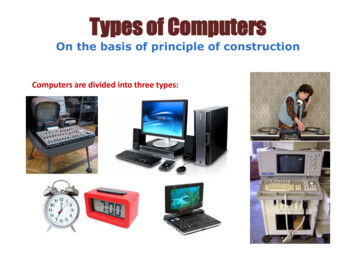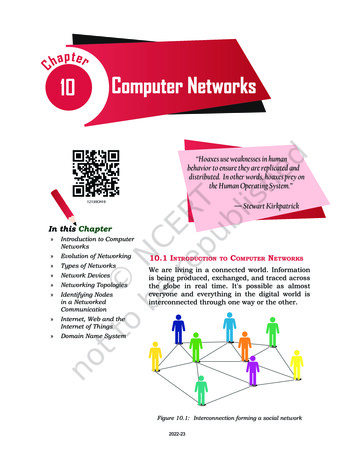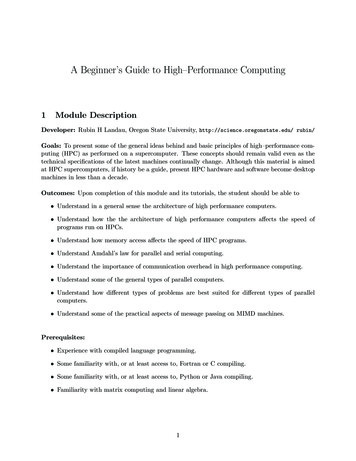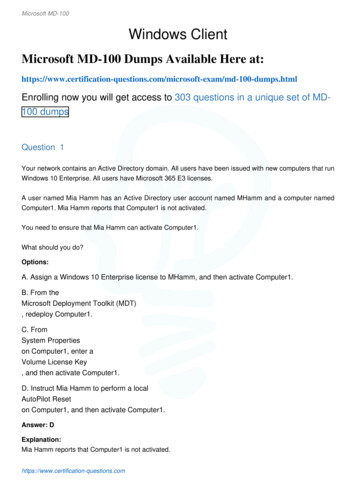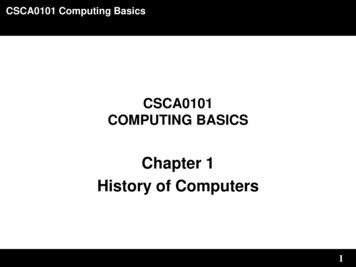
Transcription
CSCA0101 Computing BasicsCSCA0101COMPUTING BASICSChapter 1History of Computers1
CSCA0101 Computing BasicsHistory of ComputersTopics1.2.3.4.Definition of computerEarliest computerComputer HistoryComputer Generations2
CSCA0101 Computing BasicsHistory of ComputersDefinition of Computer Computer is a programmable machine.Computer is a machine that manipulates dataaccording to a list of instructions.Computer is any device which aids humans inperforming various kinds of computations orcalculations.3
CSCA0101 Computing BasicsHistory of ComputersDefinition of ComputerThree principles characteristic of computer: It responds to a specific set of instructions in a welldefined manner.It can execute a pre-recorded list of instructions.It can quickly store and retrieve large amounts ofdata.4
CSCA0101 Computing BasicsHistory of ComputersEarliest Computer Originally calculations were computed by humans,whose job title was computers.These human computers were typically engaged in thecalculation of a mathematical expression.The calculations of this period were specialized andexpensive, requiring years of training in mathematics.The first use of the word "computer" was recorded in1613, referring to a person who carried outcalculations, or computations, and the word continuedto be used in that sense until the middle of the 20thcentury.5
CSCA0101 Computing BasicsHistory of ComputersTally SticksA tally stick was an ancient memory aid device torecord and document numbers, quantities, or evenmessages.Tally sticks6
CSCA0101 Computing BasicsHistory of ComputersAbacus An abacus is a mechanical device used to aid anindividual in performing mathematical calculations.The abacus was invented in Babylonia in 2400 B.C.The abacus in the form we are most familiar withwas first used in China in around 500 B.C.It used to perform basic arithmetic operations.7
CSCA0101 Computing BasicsHistory of ComputersAbacusEarlier AbacusModern Abacus8
CSCA0101 Computing BasicsHistory of ComputersNapier’s Bones Invented by John Napier in1614.Allowed the operator tomultiply, divide andcalculate square and cuberoots by moving the rodsaround and placing them inspecially constructed boards.John NapierNapier’s Bones9
CSCA0101 Computing BasicsHistory of ComputersSlide Rule Invented by William Oughtredin 1622. Is based on Napier's ideasabout logarithms. Used primarily for– multiplication– division– roots– logarithms– Trigonometry Not normally used for additionor subtraction.William OughtredSlide Rule10
CSCA0101 Computing BasicsHistory of ComputersPascaline Invented by Blaise Pascal in1642.It was its limitation to additionand subtraction.It is too expensive.Blaise PascalPascaline11
CSCA0101 Computing BasicsHistory of ComputersStepped Reckoner Invented by GottfriedWilhelm Leibniz in 1672.The machine that can add,subtract, multiply and divideautomatically.Gottfried Wilhelm LeibnizStepped Reckoner12
CSCA0101 Computing BasicsHistory of ComputersJacquard Loom The Jacquard loom is a mechanical loom,invented by Joseph-Marie Jacquard in 1881.It an automatic loom controlled by punched cards.Joseph-Marie JacquardJacquard Loom13
CSCA0101 Computing BasicsHistory of ComputersArithmometer A mechanical calculator inventedby Thomas de Colmar in 1820,The first reliable, useful andcommercially successfulcalculating machine.The machine could perform thefour basic mathematic functions.The first mass-producedcalculating machine.Thomas de ColmarArithmometer14
CSCA0101 Computing BasicsHistory of ComputersDifference Engine and Analytical Engine It an automatic, mechanical calculator designed totabulate polynomial functions.Invented by Charles Babbage in 1822 and 1834It is the first mechanical computer.Charles BabbageDifferenceEngineAnalyticalEngine15
CSCA0101 Computing BasicsHistory of ComputersFirst Computer Programmer In 1840, Augusta Ada Byronsuggests to Babbage that he usethe binary system.She writes programs for theAnalytical Engine.Augusta Ada Byron16
CSCA0101 Computing BasicsHistory of ComputersScheutzian Calculation Engine Invented by Per Georg Scheutz in1843.Based on Charles Babbage'sdifference engine.The first printing calculator.Per Georg ScheutzScheutzian Calculation Engine17
CSCA0101 Computing BasicsHistory of ComputersTabulating Machine Invented by HermanHollerith in 1890.To assist in summarizinginformation and accounting.Herman HollerithTabulating Machine18
CSCA0101 Computing BasicsHistory of ComputersHavard Mark 1 Also known as IBM AutomaticSequence Controlled Calculator(ASCC).Invented by Howard H. Aiken in1943The first electro-mechanicalcomputer.Howard H. AikenMark 119
CSCA0101 Computing BasicsHistory of ComputersZ1 The first programmable computer.Created by Konrad Zuse inGermany from 1936 to 1938.To program the Z1 required thatthe user insert punch tape into apunch tape reader and all outputwas also generated throughpunch tape.Konrad ZuseZ120
CSCA0101 Computing BasicsHistory of ComputersAtanasoff-Berry Computer (ABC) It was the first electronic digital computing device.Invented by Professor John Atanasoff andgraduate student Clifford Berry at Iowa StateUniversity between 1939 and 1942.Professor John AtanasoffAtanasoff-Berry Computer21
CSCA0101 Computing BasicsHistory of ComputersENIAC ENIAC stands for ElectronicNumerical Integrator andComputer.It was the first electronic generalpurpose computer.Completed in 1946.Developed by John PresperEckert and John W. Mauchl.ENIAC22
CSCA0101 Computing BasicsHistory of ComputersUNIVAC 1 The UNIVAC I (UNIVersal Automatic Computer 1)was the first commercial computer.Designed by J. Presper Eckert and JohnMauchly.UNIVAC 123
CSCA0101 Computing BasicsHistory of ComputersEDVAC EDVAC stands for ElectronicDiscrete Variable AutomaticComputerThe First Stored ProgramComputerDesigned by Von Neumann in 1952.It has a memory to hold both astored program as well as data.EDVAC24
CSCA0101 Computing BasicsHistory of ComputersThe First Portable Computer Osborne 1 – the first portable computer.Released in 1981 by the Osborne ComputerCorporation.Osborne 125
CSCA0101 Computing BasicsHistory of ComputersThe First Computer Company The first computer company was the ElectronicControls Company.Founded in 1949 by J. Presper Eckert and JohnMauchly.26
CSCA0101 Computing BasicsHistory of ComputersComputer GenerationsThere are five generations of computer: First generation – 1946 - 1958Second generation – 1959 - 1964Third generation – 1965 - 1970Fourth generation – 1971 - todayFifth generation – Today to future27
CSCA0101 Computing BasicsHistory of ComputersThe First Generation The first computers used vacuumtubes for circuitry and magneticdrums for memory, and were oftenenormous, taking up entire rooms. They were very expensive to operateand in addition to using a great deal ofelectricity, generated a lot of heat,which was often the cause ofmalfunctions.Vacuum tube28
CSCA0101 Computing BasicsHistory of ComputersThe First Generation First generation computers relied on machinelanguage, the lowest-level programming languageunderstood by computers, to perform operations,and they could only solve one problem at a time. Input was based on punched cards and paper tape,and output was displayed on printouts.29
CSCA0101 Computing BasicsHistory of ComputersThe Second Generation Transistors replaced vacuum tubesand ushered in the second generationof computers.One transistor replaced theequivalent of 40 vacuum tubes.Allowing computers to becomesmaller, faster, cheaper, moreenergy-efficient and more reliable.Still generated a great deal of heatthat can damage the computer.Transistor30
CSCA0101 Computing BasicsHistory of ComputersThe Second Generation Second-generation computers moved from crypticbinary machine language to symbolic, or assembly,languages, which allowed programmers to specifyinstructions in words.Second-generation computers still relied on punchedcards for input and printouts for output.These were also the first computers that stored theirinstructions in their memory, which moved from amagnetic drum to magnetic core technology.31
CSCA0101 Computing BasicsHistory of ComputersThe Third Generation The development of the integratedcircuit was the hallmark of the thirdgeneration of computers.Transistors were miniaturized andplaced on silicon chips, calledsemiconductors, which drasticallyincreased the speed and efficiency ofcomputers.Much smaller and cheaper compareto the second generation computers.It could carry out instructions inbillionths of a second.Integrated Circuit32
CSCA0101 Computing BasicsHistory of ComputersThe Third Generation Users interacted with third generation computersthrough keyboards and monitors and interfaced withan operating system, which allowed the device torun many different applications at one time with acentral program that monitored the memory.Computers for the first time became accessible to amass audience because they were smaller andcheaper than their predecessors.33
CSCA0101 Computing BasicsHistory of ComputersThe Fourth Generation The microprocessor brought thefourth generation of computers, asthousands of integrated circuitswere built onto a single silicon chip.As these small computers becamemore powerful, they could be linkedtogether to form networks, whicheventually led to the developmentof the Internet.Fourth generation computers alsosaw the development of GUIs, themouse and handheld devices.Microprocessor34
CSCA0101 Computing BasicsHistory of ComputersThe Fifth Generation Based on Artificial Intelligence (AI).Still in development.The use of parallel processing and superconductorsis helping to make artificial intelligence a reality.The goal is to develop devices that respond tonatural language input and are capable of learningand self-organization.There are some applications, such as voicerecognition, that are being used today.35
CSCA0101 Computing Basics 21 History of Computers Atanasoff-Berry Computer (ABC) It was the first electronic digital computing device. Invented by Professor John Atanasoff and graduate student Clifford Berry at Iowa State University between 1939 and 1942. Professor


